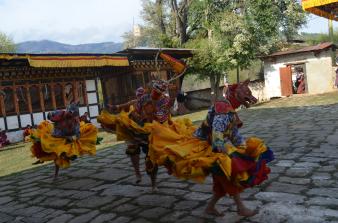EE00000016
 Shawa Sha-khe/che Chham: The Dance of the Stag and Hounds
Shawa Sha-khe/che Chham: The Dance of the Stag and Hounds
Shawa Sha-khe/chi Chham (the mask dance of the stag and the hounds) or also called as Acho Phen-to (the Hunter and the servant) by its character is one of the mask dances that falls under the Nam-thar zhi-chol gi gar-chham (biography-based mask dances) category of three broad classifications of mask dances in the Bhutan. This mask dance has a characteristic of theatrical play extracted from the life story of Milarepa (1052-1135) and has various characters and episodes basically conveying the Buddhist principals of compassion, arising faith and human values that lead to a harmonious life.
The origin of the mask dance dates back to the 11th century when Jetsun (venerable) Milarepa the great yogi from Tibet, converted Gonpo Dorji, a fierce hunter as his disciple who later listed as became one of his principal followers named as Khe-rawa Gonpo Dorji. In brief, the story goes as follows: While Milarepa was meditating in a cave known as Katya in Nyishangkurta (on the present-day border between the Tibetan autonomous region of China and Nepal), he heard a couple of hounds barking somewhere near to his hermitage. In a short while, a stag glistening with sweat and exhausted bounds into his cave indirectly seeking refuge from the lean and thin meditator Milarepa. Out of great and compassion and pity, Milarepa sangs a song to calm the terrified stag, which eventually laid down peacefully near to the great yogi in the cave. Led by the scent of the stag, two ferocious hounds; a red and a black-coloured appeared in lightning speed, rushed inside the cave in pursuit of the stag. Milarepa also calms them by singing yet another stanza of song dedicating to the hounds which subsides its rage and calmly sits beside Milarepa waggling its tail alike to their owner.
Subsequently, the merciless hunter, the owner of the dogs, Gonpo Dorje soon arrives in pursuit of his target, the hounds, and steped into the cave frustrated, drenched in sweats, tired and a bow and arrow ready to release the trigger. The sight of his hounds and the stag calmly sitting together with Milarepa infuriates him, thinking that the yogi has used some kind of black magic on the animals. Dragged by his rage, he shoots an arrow at Milarepa which in-turn slips the arrow from his bowstring. Milarepa then sings the hunter a song to calm his mind and open it to the Dharma, but the hunter remains uncertain whether Milarepa is a great saint or else a black magic practitioner. Gonpo Dorje inspected Milarepa’s cave, and upon noticing nothing in it but an empty bowl surprised him. Overwhelmed by feelings of profound respect for Milarepa, feled deep remorse for all his past sinful actions and thereafter vowed never to commit such acts and became a faithful disciple.
The mask dance has various characters such as; Shawa (the Stag), Sha-khi/che (two hounds), Acho (the hunter), Phen-to (servant), Milarepa (the Saint) and a package of Atsa-ra (clowns). The mask dance is performed only during the annual Tshe-chu (Mask Dance Festival) with several episodes portraying different scenes. The element is still vibrant in the country.
Bhutan


